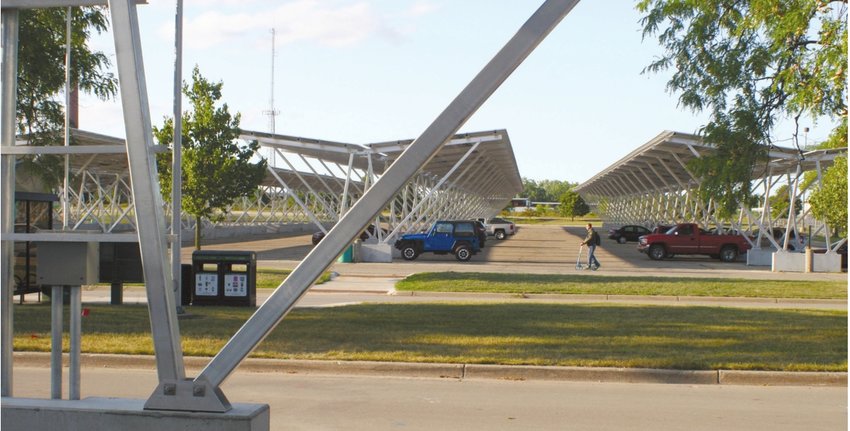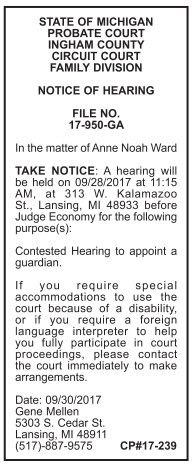 MSU solar carport array will be the biggest in the nation
MSU solar carport array will be the biggest in the nation Lord, how can we ever atone for paving paradise and putting up a parking lot?
Two words: Solar carports. Last week, students, staff and even game-day tailgaters at Michigan State University nestled under a vast, roosting swarm of silver metal wings that are descending by the thousands onto the alfalfa fields and turf-grass testing areas of south campus. Even monster RVs parked and partied under the 14-foot clearance of the carports with ease.
Five of MSU’s largest parking lots, with a combined acreage of 45 acres, are being outfitted with the nation’s, and possibly the world’s, biggest array of solar carports.
The 10 MW array is expected to generate about 15,000 megawatt hours a year, about 5 percent of the electricity used on campus. The Solar Energy Industries Association confirmed that it will be the biggest solar carport array in the nation when finished in December.
The next largest, at Rutgers University, produces about half the energy of MSU’s is expected to generate.
MSU physics professor Wolfgang Bauer, an adviser on the project, said the MSU array is “very likely” the largest in the world, but such superlatives are difficult to confirm.
On sunny summer days, the array will satisfy about one-fifth of the university’s peak load.
“The electricity we produce with these arrays each year is enough to completely supply 1,800 average Michigan households with all their electricity,” Bauer said.
About 5,000 of the 5,200 parking spaces in the five lots will be covered when the project is finished. The project was scaled back slightly when workers found that about 200 spaces are shaded by trees that block the sunlight. Rather than cutting the trees down, planners opted to leave the spaces uncovered.
Work has gotten farthest at Lot 89, at Farm Lane and Mt. Hope Road, with about half the panels in place as of last weekend. All the panels at Lot 89 are expected to be up and generating electricity by Halloween. The entire project will be finished by the end of the year, Bauer said.
The slanted carports make the lots look like vast drive-in burger joints from the 1950s, scaled to the planet Jupiter. Bauer said aesthetic considerations were built into the design.
“We wanted to make sure they look nice,” he said. “That way, people are more likely to take care of them.”
Self-dimming LED lights with motion detectors under the carports keep the lots lit “at very low energy consumption” — three to six volts, Bauer said.
Researching and teaching how best to exploit, and steward, the land is part and parcel of MSU’s land-grant pedigree. MSU has high hopes the array will prove the cost effectiveness of large-scale solar carport projects. Private investors are paying the $20 million for the project and selling the energy to MSU at a fixed price for 25 years.
The project covers an area that is about equal to every rooftop on MSU’s campus combined. But rooftops, bristling with equipment and scattered in a sea of trees, aren’t the best places for solar panels at park-like places such as MSU.
“We didn’t want to give up 60 acres of farmland for a solar farm,” Bauer said.
“But it’s the optimum use when you’re already using the land.”
The fixed energy costs locked into the 25-year power purchase agreement will allow MSU to dodge the 2 to 3 percent annual increase in electricity prices that have taken place in the last 10 years and are expected to continue for the next 20 years, according to the Information Energy Agency of the U.S. Energy Department. Bauer said MSU expects to save about $10 million over the next 25 years, relative to buying the same amount of energy off the grid.
Several representatives of private companies and other entities have already contacted Bauer for information about the carports and some have toured the lots. Bauer declined to publicly pressure the interested parties by naming names — except Indiana University, which sent a delegation last month. (The notion of Spartans leading Hoosiers was too irresistible for him to pass up.)
MSU’s hopes of leading the state in a solar carport revolution had Bauer too excited to stop there. Airports, he said, would be a perfect application.
“Malls, large shopping centers too,” he said. “There’s a new Costco going up. They would be a good candidate.”
The time is ripe for such projects, Bauer said, because the efficiency curve of solar panels keeps bending toward greater cost effectiveness.
“From the time we began planning this project, about four years ago, to now, efficiency of solar panels has gone up from about 15 percent to 17 percent, meaning that 17 percent of solar radiation striking the panel is converted to energy,” he said.
By comparison, plant leaves and other natural solar panels convert solar energy at a rate of about 1 percent. That takes some of the sting out of paving paradise.
Bauer said that if the amount of energy expected from the carports were generated from coal, the university would have to plant 20 acres of forest each year to make up for the emissions.
As a University Distinguished Professor, Bauer could write his own ticket anywhere, but he likes living in Michigan. When he talks about the MSU carport project, he sticks mainly to economics, but he admitted that the thought of “making a difference” and nudging the nation further from fossil fuels deeply appeals to him.
“I hope that maybe as a consequence of Hurricane Harvey, people will finally wise up to the fact that we’re making disasters worse with global warming,” he said.
“Even a Texan, who based their economy on oil and gas, it will cause them to pause and say, ‘What are we doing to our planet?’”
Support City Pulse - Donate Today!
Comments
No comments on this item Please log in to comment by clicking here